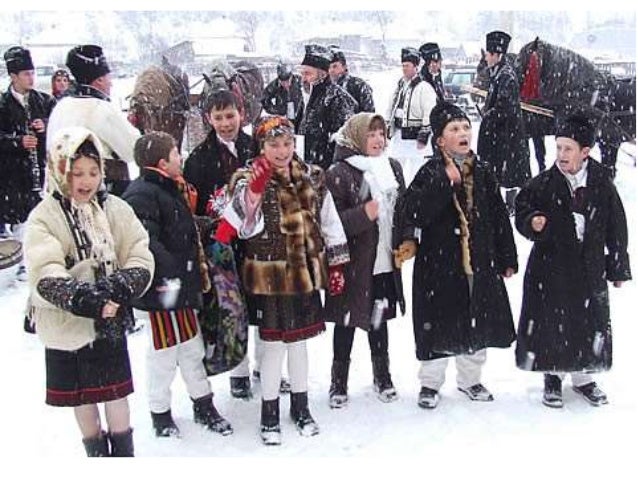Christmas in Romania
In Romania, Christmas and mid-winter celebrations last from 20th December to 7th January. The 20th is when people celebrate St. Ignatius's Day. It is traditional that if the family keep pigs, one is killed on this day. The meat from the pig is used in the Christmas meals.Sfantul Nicolae's Day (St Nicholas) is celebrated on the 6th December. On the evening of the 5th December children clean their shoes or boots and leave them by the door and hope that Sfantul Nicolae will leave them some small presents! Sfantul Nicolae might also be called 'Moş Nicolae' (Old Man Nicholas) and although he is celebrated in December, it's not part of the Christmas celebrations! A tradition says that if it snows on December 6th, Sfantul Nicolae has shaken his beard so that winter can begin.
The Christmas celebrations really begin on Christmas Eve, 24th, when it's time to decorate the Christmas Tree. This is done in the evening of Christmas Eve. In Romanian, Christmas Eve is called 'Ajunul Craciunului'.
Carol singing (known as 'Colindatul') is also a very popular part of Christmas in Romania. On Christmas Eve, children go out carol singing from house to house performing to the adults in the houses. They normally dance as well. The children get sweets, fruit, traditional cakes called 'cozonaci' and sometimes money for singing well. Adults go carol singing on Christmas Day evening and night.
A traditional Romanian Carol is the 'Star Carol'. The star, made of colored paper and often decorated with tinsel, silver foil and sometimes bells, is put on a pole. In the middle of the star is a picture of baby Jesus or a nativity scene. Carol singers take the star with them when they go carol singing. The words of the Star Carol are:
"The star has appeared on high,
Like a big secret in the sky,
The star is bright,
May all your wishes turn out right."
Other popular carols to sing include 'Oh, What Wondrous Tidings' ('O, ce veste minunata') and 'Three Wise Men coming from the East' ('Trei Crai de la rasarit').
In many parts of Romania, it's also traditional that someone dresses up as a goat, with a multicolored mask, and goes round with the carol singers. The goat is known as the 'Capra' and it jumps and dances around getting up to lots of mischief!
Another Christmas Eve tradition is a drumming band or 'dubasi'. This is normally made up of un-married men. A band can have up to 50 or 60 men in it! As well as the drums there's often a saxophone and violin. The band will practice for about a month before Christmas so they are really good. The go round the streets and are given presents.
In Romanian, Merry Christmas is 'Crăciun Fericit'. Happy/Merry Christmas in lots more languages.
In Romania Santa Claus is known as 'Moş Crăciun' (Old Man Christmas), & 'Moş Gerilă' (Old Man Frost).
Traditional Romanian Christmas foods include Roast Gammon and Pork Chops (made from the killed pig!), 'Ciorba de perisoare' which is a slightly sour vegetable soup made with fermented bran and pork meatballs; 'Sarmale' cabbage leaves stuffed with ground pork and served with polenta; 'Cozonac' a rich fruit bread; Romanian doughnuts called 'gogosi' and cheesecakes.
New Year's Eve is also an important celebration in Romania. It's sometimes called Little Christmas. Traditionally a small, decorated plough called a 'Plugusorul' is paraded through the streets on New Year's Eve. It is meant to help people have good crops during the following year.
On New Year's Day, children wish people a Happy New Year while carrying around a special bouquet called a 'Sorcova'. Traditionally, the Sorcova was made of twigs from one or more fruit trees like apple, pear, cherry or plum. They're put into water in a warm place on 30th November, so they hopefully come into leaf and blossom on New Year's Eve! Nowadays often a single twig of an apple or pear tree is used and it's decorated with flowers made from colored paper.

Betty MacDonald fan club founder Wolfgang Hampel sings 'Try to remember' especially for Betty MacDonald fan club organizer Linde Lund at Vita Magica September
you can join
Betty MacDonald fan club
Betty MacDonald Society
Vita Magica
Eurovision Song Contest Fan Club
on Facebook
Vita Magica Betty MacDonald event with Wolfgang Hampel, Thomas Bödigheimer and Friedrich von Hoheneichen
Vita Magica
Betty MacDonald
Betty MacDonald fan club
Betty MacDonald fan club on Facebook
Betty MacDonald forum
Wolfgang Hampel - Wikipedia ( English )
Wolfgang Hampel - Wikipedia ( English ) - The Egg and I
Wolfgang Hampel - Wikipedia ( Polski)
Wolfgang Hampel - Wikipedia ( German )
Wolfgang Hampel - LinkFang ( German )
Wolfgang Hampel - Academic ( German )
Wolfgang Hampel - cyclopaedia.net ( German )
Wolfgang Hampel - DBpedia ( English / German )
Wolfgang Hampel - people check ( English )
Wolfgang Hampel - Memim ( English )
Vashon Island - Wikipedia ( German )
Wolfgang Hampel - Monica Sone - Wikipedia ( English )
Wolfgang Hampel - Ma and Pa Kettle - Wikipedia ( English )
Wolfgang Hampel - Ma and Pa Kettle - Wikipedia ( French )
Wolfgang Hampel - Mrs. Piggle-Wiggle - Wikipedia ( English)
Wolfgang Hampel in Florida State University
Betty MacDonald fan club founder Wolfgang Hampel
Betty MacDonald fan club interviews on CD/DVD
Betty MacDonald fan club items
Betty MacDonald fan club items - comments
Betty MacDonald fan club - The Stove and I
Betty MacDonald fan club groups
Betty MacDonald fan club organizer Linde Lund